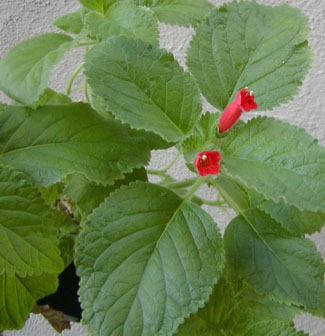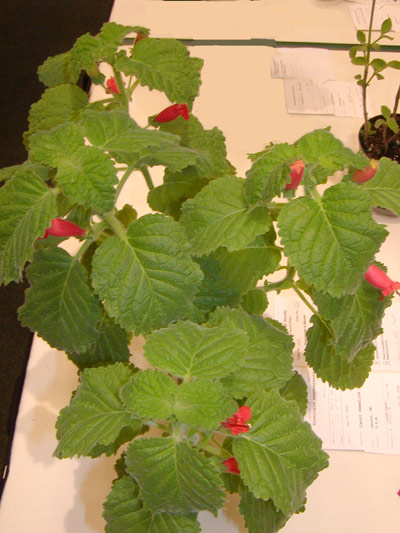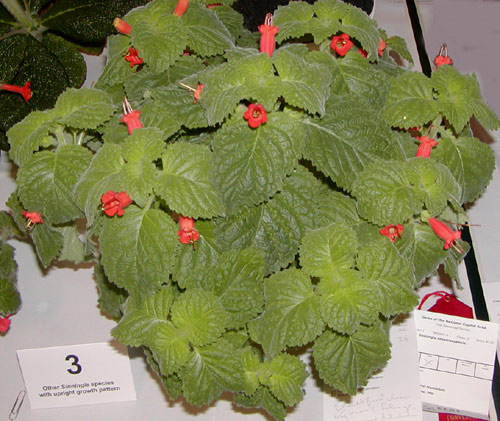
Sinningia amambayensis
Sinningia amambayensis is notable for its sticky leaves.
| Species list |
Hybrids list |
Tubers list |
Topics list |
Site index |
What's new |
Home page |

|
Sinningia amambayensisSinningia amambayensis is notable for its sticky leaves. |
|
Sinningia amambayensis
|

|
Although this picture shows the same plant as above, the leaves look paler due to not very skillful photoshopping in an attempt to bring out the flowers. |
CultureCulture is easy, except for one peculiarity, at least in my conditions. The plants I have placed outdoors have all gone dormant in winter but not come back the next year. My indoor plants of this species are not deciduous, but retain their leaves all year. GroomingGrooming this species for show can be frustrating, because of its sticky leaves. It produces abundant pollen, the pollen drops on the leaves where it is almost impossible to remove completely, and judges sometimes mistake the pollen for mildew. A picture shows one possible explanation for the leaf stickiness: S. amambayensis fighting back against its enemies. |

|
Quantity of BloomAt the 2006 Gesneriad Society convention in Rochester, New York, Carol Hamelink of Laurel, Maryland, exhibited a very nice plant of S. amambayensis, with four vigorous shoots. The judges marked it down for "quantity of bloom", leading to a post-convention discussion on the Gesneriphiles mailing list. Mauro Peixoto wrote that a stem of this plant normally has only two flowers open at any given time -- the flowers at the next node up the stem open about the time that the previous two are falling. I went to check my own plant, which had seven sprawling stems (and therefore didn't look nearly as attractive as Carol's show plant), and sure enough, each of the stems had only two flowers. Even though the species does not usually have a large number of flowers open at one time, it does have a long blooming season, from late spring or early summer deep into winter. The bright green foliage and bright red flowers are very cheerful in December and January. |
|
Three years later, at the convention in Silver Spring, Maryland (near Washington DC), the plant looked like this. Again there was some discussion about the quantity of bloom. Sigh. |

|
Sinningia amambayensis has an unusual fruit. There is picture and a discussion.

|
HabitatAlain Chautems sent me this picture of S. amambayensis in the wild, showing the dead leaves retained on the lower stem. He suggests that they might be protection from cold during the winter. This seems plausible, since plants of this species which I left outdoors but cut back to the tuber did not come back in the spring. Alain referenced the Portuguese-language Wikipedia page for Ponta Poră, a city on the Brazilian side of the border with Paraguay but still in the Amambaya Mountains (see below). Altitude there is 670 m [about 2300 feet]. This page gives an average winter minimum of 5 C [41 F] but a lowest recorded temperature of -6 C [21 F]. Of course, lowest recorded minimums tend to lay waste to gardens everywhere, so there is no guarantee that S. amambayensis can survive that. |
The Mamba GroupA number of sinningia species have the following properties:
The species are
S. nordestina (anthers barely exserted) is similar, and S. valsuganensis might also qualify. I call this small cluster of species the Mamba Group. They are all in the Corytholoma clade. The nuclear DNA data have these three species quite close, and S. valsuganensis not far away, although S. nordestina is somewhat distant. However, the chloroplast DNA gives conflicting results, so it is unclear whether the Mamba Group is a taxonomic reality, a product of convergent evolution, or a figment of my imagination. |
HybridizationI have done two crosses with S. amambayensis. The results looked a lot like S. amambayensis. Especially, they felt a lot like it: the same sticky leaves! One cross was with S. sulcata, using pollen supplied by Jon Dixon. During their early years, the resulting plants tended to have one primary stem, unlike the bushy amambayensis parent. However, as years went by, they became shrubbier. Two of the plants are still alive in December 2022. The flowers are the same general shape as those of S. amambayensis, but the corolla lobes are a peachy color, both inside and out, which is a nice effect. The most distinctive feature is the pistil. The stigma extends waaaay beyond the corolla tube (see the picture below). Like the S. amambayensis parent, it is not a heavy bloomer, with only a 1-3 flowers open at a time, even on a relatively large plant. |

|
|
While the plants of the above cross were clearly different from the S. amambayensis seed parent, the same cannot be said with 100% certainty of the results of the other cross (which was actually done a year earlier). The flowers of the hybrid S. amambayensis x nordestina (assuming that is what it truly is and not a selfing) are similar in many respects to those of S. amambayensis, but for a few differences.
This plant is probably a cross, all right. Still, it would be comforting if at least something about the hybrid reminded one of S. nordestina. [Postscript: One other feature was very reminiscent of S. nordestina: its short life span. This hybrid did not come out of dormancy one year, so it is extinct until somebody recreates it.] |
|
Here is a table which compares the three plants.
| Feature | S. amambayensis | ... x sulcata | ... x nordestina |
|---|---|---|---|
| Habit | Sprawls, branching at base | Main stem with small side branches along stem. Shrubby with age. | Sprawls, branching at base |
| Flower color | Red-orange | Red-pink with peach-colored lobes | Red-orange |
| Flowers per axil | One (sometimes two) | One (sometimes two) | Three-four |
| Pistil | Thin style with stigma barely exserted | Even thinner style extending well beyond corolla tube | Robust dark-red style with stigma clear of corolla tube |
| Plant Description |
|
| Growth | Indeterminate |
| Habit | Stems usually prostrate or creeping, flowers borne in leaf axils. |
| Leaves | Green, hairy, sticky |
| Dormancy | In my cultivation, if this species goes dormant, it often does not revive. Mine are evergreen. |
Flowering |
|
| Inflorescence | Axillary cyme, usually just one flower |
| Season | Blooms at intervals from spring through autumn |
| Flower | Red, tubular; buds are yellow. Anthers are exserted. |
Horticultural Aspects |
|
| Hardiness | None of mine which I put outdoors came back in the spring. |
| Propagation | Stem cuttings root easily and retain developing flowerbuds, if enclosed. Seed sowing also has a high success rate (seeds are relatively large for a sinningia). |
| Recommended? | Yes. Long blooming season! |
Botany |
|
| Taxonomic group | The tall-or-sticky group of the Corytholoma clade. |
Chautems, 1992.
Etymology: Amambaya + -ensis ("resident of"). La Sierra de Amambaya is in Paraguay. Mountain ranges often ignore national and linguistic borders, and when this one crosses into Brazil, it is known as a Serra de Amambai. This species has been found on both sides of the border.